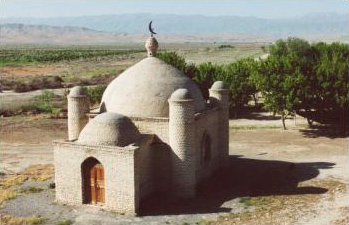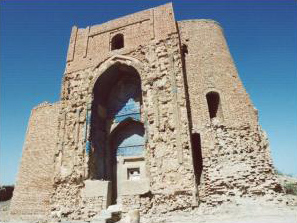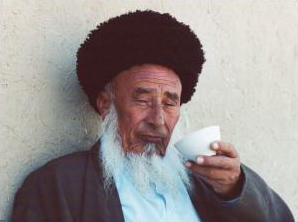Turkmenistan & Uzbekistan
Day 3 - Monday, 24 April 2000
Mary and Merv
On Monday we started out early to make the long journey to the Russian city of Mary, next to the ruined city of Merv. But there were stops to be made along the way.
Our first stop was the ruins of the city of Anau. Camels were first domesticated here, we were told. It was a Parthian city from the time of Alexander the Great until 300 A.D. The son of Mohammed is buried here, and it is a holy site to Muslims. On the grave are hairpins and buttons, left as a token of prayer. A nearby pole is tied with strips of cloth, in the style of the wish tree. Magnificent ruins were standing here until the 1948 earthquake, which left it a pile of rubble. Many of the fallen bricks have been stacked by petitioners in certain ways to make their wishes, or prayers.

A small mosque has been built at the site and many Muslims
make it a place of pilgrimage.
There is an ancient history here, of a beautiful maid named Jemalle, a very beautiful maid who did good things for people. One night a dragon came and rang the bell. Jemalle followed the dragon and found a second dragon caught on a goat's horn. She rescued him.
As we continued our journey through the Karakum desert, we were captivated by the camels grazing peacefully among the scattered plants. Our guide told us that the camels are allowed to go out on their own to graze and pasture themselves, and that they come home of their own accord in the evening. But later in the day, we observed a man on horseback encouraging them on their way.
We saw a mirage in the desert, it looked like a shimmering lake. But there was no edge of green growth, such as you would expect to find beside fresh water.
We also watched a train with at least 50 tank cars. It traveled parallel to us for a period of time. Our bus and the train crossed open channels of water diverted from the Amu Darya river into the desert to grow cotton. About the time we were watching the train we were only about three miles from the Iranian border.

We turned from the main road and drove a long way out to Myana Baba, and Abu Sehit's mausoleum. I think we were told that he was a father of Sufism. Many people come here for pilgrimage.
An older couple lives at the mausoleum as caretakers. The woman who lives here is 64 years old. She has made the pilgrimage to Mecca 5 times and has also been to Medina. She said she had met a woman who knew how to read the Koran; this woman told her that most people walk around the black stone 7 times, but the Koran says it should be 30. Armed with this knowledge our hostess was able to walk around 30 times. The other people thought she was a very holy woman. She did not tell them that she lived in Myana Baba, which had accustomed her to the heat. If they knew she was from here, they would think she had the "evil eye" or spiritual power.
It was very crowded in Mecca, she said, and her brother's son died from carbon monoxide in the tunnel.

Her husband is 62 years old, and has had heart surgery.
There was also a historian who came to meet us here. He has done much research on this site and the man who is buried here, and has written books. He wanted to tell us more, to take us out to Altin Depe (Golden Hill) and show us the archeological dig. But when our bus driver saw the road he would have to travel, he refused to go further. Perhaps it was just as well. It was a long way yet to Mary.
As dark drew near, our driver drove faster and faster. Soon we realized that many people drive without lights. There is a curfew for the roads, and no one is allowed to drive after 10 pm. So the driver knew he had to get us to Mary before that time.
Even so, we were so late arriving, that Jim & I decided not to join the others for dinner, and just go to bed early. The hotel was a shocker. It is from the Russian time, and is very old and neglected. The bathroom was clean but well below Western standards.